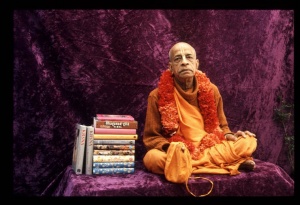CC Adi 5.27-28

A.C. Bhaktivedanta Swami Prabhupada
TEXTS 27-28
- svarūpa-vigraha kṛṣṇera kevala dvi-bhuja
- nārāyaṇa-rūpe sei tanu catur-bhuja
- śaṅkha-cakra-gadā-padma, mahaiśvarya-maya
- śrī-bhū-nīlā-śakti yāṅra caraṇa sevaya
SYNONYMS
svarūpa-vigraha — personal form; kṛṣṇera — of Lord Kṛṣṇa; kevala — only; dvi-bhuja — two hands; nārāyaṇa-rūpe — in the form of Lord Nārāyaṇa; sei — that; tanu — body; catuḥ-bhuja — four-handed; śaṅkha-cakra — conchshell and disc; gadā — club; padma — lotus flower; mahā — very great; aiśvarya-maya — full of opulence; śrī — named śrī; bhū — named bhū; nīlā — named nīlā; śakti — energies; yāṅra — whose; caraṇa sevaya — serve the lotus feet.
TRANSLATION
Kṛṣṇa’s own form has only two hands, but in the form of Lord Nārāyaṇa He has four hands. Lord Nārāyaṇa holds a conchshell, disc, club and lotus flower, and He is full of great opulence. The śrī, bhū and nīlā energies serve at His lotus feet.
PURPORT
In the Rāmānuja and Madhva sects of Vaiṣṇavism there are extensive descriptions of the śrī, bhū and nīlā energies. In Bengal the nīlā energy is sometimes called the līlā energy. These three energies are employed in the service of four-handed Nārāyaṇa in Vaikuṇṭha. Relating how three of the Ālvārs, namely Bhūta-yogī, Sara-yogī and Bhrānta-yogī, saw Nārāyaṇa in person when they took shelter at the house of a brāhmaṇa in the village of Gehalī, the Prapannāmṛta of the Śrī-sampradāya describes Nārāyaṇa as follows:
- tārkṣyādhirūḍhaṁ taḍid-ambudābhaṁ
- lakṣmī-dharaṁ vakṣasi paṅkajākṣam
- hasta-dvaye śobhita-śaṅkha-cakraṁ
- viṣṇuṁ dadṛśur bhagavantam ādyam
- ā-jānu-bāhuṁ kamanīya-gātraṁ
- pārśva-dvaye śobhita-bhūmi-nīlam
- pītāmbaraṁ bhūṣaṇa-bhūṣitāṅgaṁ
- catur-bhujaṁ candana-ruṣitāṅgam
“They saw the lotus-eyed Lord Viṣṇu, the Supreme Personality of Godhead, mounted on Garuḍa and holding Lakṣmī, the goddess of fortune, to His chest. He resembled a bluish rain cloud with flashing lightning, and in two of His four hands He held a conchshell and disc. His arms stretched down to His knees, and all His beautiful limbs were smeared with sandalwood and decorated with glittering ornaments. He wore yellow clothes, and by either side stood His energies Bhūmi and Nīlā.”
There is the following reference to the śrī, bhū and nīlā energies in the Sītopaniṣad: mahā-lakṣmīr deveśasya bhinnābhinna-rūpā cetanācetanātmikā. sā devī tri-vidhā bhavati, śakty-ātmanā icchā-śaktiḥ kriyā-śaktiḥ sākṣāc-chaktir iti. icchā-śaktis tri-vidhā bhavati, śrī-bhūmi-nīlātmikā. “Mahā-Lakṣmī, the supreme energy of the Lord, is experienced in different ways. She is divided into material and spiritual potencies, and in both features she acts as the willing energy, creative energy and the internal energy. The willing energy is again divided into three, namely śrī, bhū and nīlā.”
Quoting from the revealed scriptures in his commentary on the Bhagavad-gītā (BG 4.6), Madhvācārya has stated that mother material nature, which is conceived of as the illusory energy, Durgā, has three divisions, namely śrī, bhū and nīlā. She is the illusory energy for those who are weak in spiritual strength because such energies are created energies of Lord Viṣṇu. Although each energy has no direct relationship with the unlimited, they are subordinate to the Lord because the Lord is the master of all energies.
In his Bhagavat-sandarbha (Text 23), Śrīla Jīva Gosvāmī Prabhu states, “The Padma Purāṇa refers to the eternally auspicious abode of Godhead, which is full in all opulences, including the energies śrī, bhū and nīlā. The Mahā-saṁhitā, which discusses the transcendental name and form of Godhead, also mentions Durgā as the potency of the Supersoul in relationship with the living entities. The internal potency acts in relation with His personal affairs, and the material potency manifests the three modes.” Quoting elsewhere from the revealed scriptures, he states that śrī is the energy of Godhead that maintains the cosmic manifestation, bhū is the energy that creates the cosmic manifestation, and nīlā, Durgā, is the energy that destroys the creation. All these energies act in relation with the living beings, and thus they are together called jīva-māyā.